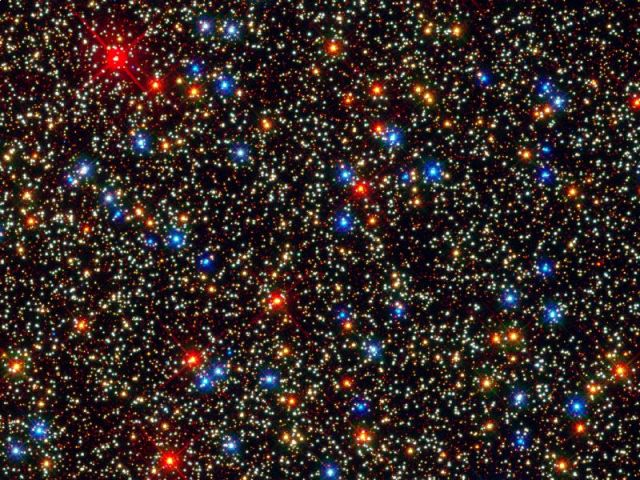The Hubble Space Telescope took a panoramic image of about one hundred thousand stars in a multitude of colors residing in the bustling core of the giant cluster.

The Hubble Space Telescope took a panoramic image of about one hundred thousand stars in a multitude of colors residing in the bustling core of the giant cluster.
The image reveals a small area within the globular cluster Omega Centauri, which contains about 10 million stars. A globular cluster, an ancient swarm of stars united by gravity owns the mansions of the Milky Way. The age of the stars in the cluster ranges from 10 to 12 billion years. The cluster itself is about 16 light years away from Earth.
This is one of the first images taken by the Planetary/Wide-Field Camera #3 that was installed on Hubble's last servicing mission in May 2009. The camera can take sharp images over a wide range of wavelengths. The image shows the camera's color flexibility by exposing a variety of stars at different stages of their life cycle.
The vast majority of the stars in the picture are yellow-white in color, like our sun. These are mature stars that shine thanks to the hydrogen fusion process. Towards the end of their normal life they become colder and larger. At this late stage of their life their color is orange and these are the orange dots in the picture.
Even in the later stages of their life cycle, the stars continue to cool and expand and become red giants. These are the bright red stars that swell to several times the size of our sun and begin to shed their outer gas mantle.
After shedding most of their mass and exhausting most of their hydrogen fuel, the stars appear bright blue in color. Only a thin layer of materials covers their very hot core. These are stars that are desperately trying to extend their lives by fusing helium in their shells. At this point, they emit most of their light in the ultraviolet range.
When the helium runs out, the stars reach the end of their lives. Only their extinguished cores remain, and they are called white dwarfs (the blue dots are pale in the picture). White dwarfs no longer produce energy through nuclear fusion and gravitationally all that remains is an Earth-sized object. They will continue to cool and dim for billions of years until they become a dark ember.
Other stars visible in the image are called blue trailers. These are old stars that acquired life extension when they collided and merged with other stars. The encounter speeds up the energy production rate of the stars and makes them bluer.
These stars are also intimate neighbors of each other. The average distance between every two stars in the cluster is about a third of a light year, about 13 times closer to the Sun than our stellar neighbor - Alpha Centauri. Although the stars are very close, the sharpness of Planetary Camera #3 can separate each one and see it as an individual star. If someone lived inside the globular cluster, they would have a starry sky 100 times brighter than Earth's sky.
Globular clusters were considered to include stars born around the same date. However, today there is evidence that Omega Centauri has at least two stellar populations of different ages. Some astronomers believe that the cluster may be the remnant of a small galaxy that crashed into the Milky Way due to gravity and lost most of its stars and gas.
Omega Centauri is one of the most massive among the approximately 200 known globular clusters in the Milky Way. It is one of the few clusters that can be seen with the naked eye. The cluster was named by Johann Bayer in 1603 as the 24th brightest object in the Centaurus group. It resembles a small cloud in the southern sky and may easily confuse viewers who will think they are watching a comet.
Hubble observed the Omega Centauri cluster on July 15, 2009 in the ultraviolet and visible light.
.
More on the subject on the science website

9 תגובות
It would be nice if it was possible to enlarge the image
Why isn't astronomy taught as a compulsory subject in school and besides that you can post more pictures on the internet.
Yiftach
You're right, that's a good point
Stop already, obviously this picture was made in Photoshop.... 🙂
will open:
The first part of your statement is correct, but the second part is incorrect.
The entire cluster is located about 16 thousand light years from us and its entire diameter is about 170 light years.
Therefore, the most distant star in the cluster is about one percent more distant from us than the nearest star.
http://en.wikipedia.org/wiki/Omega_Centauri
L.N.C.
The XNUMXD is compressed in the image to XNUMXD.
Two nearby stars in the picture, the other can be 10 times farther from us than the other.
L.N.C.
There is a good parallel to this "illusion". The facet is actually found, common sense says that it is made of a uniform hard, but the truth is that the distance between the particles of the material is huge and many in relation to the size of the particles themselves...
God's creation is amazing.
We are only at the beginning of space photography.
I'm just waiting for the day we photograph a distant star that a large spacecraft is parked next to.
How far are we from that...probably only time is the answer.
Common sense is simply unable to contain the size of the universe. Despite the enormous density you see in the picture
(Even if you magnify 1000 times the stars will still look quite close relative to their diameters to each other}.
It's hard to believe that the average distance between a star and its nearest neighbor is something like 3 trillion km...
So why do they look so close to each other?